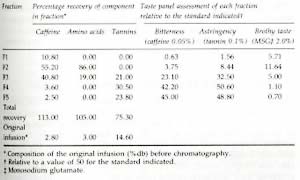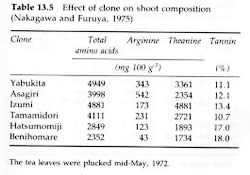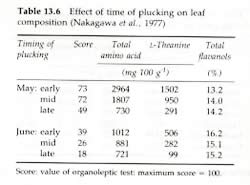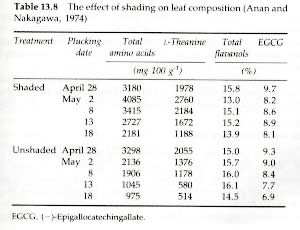* Japanese green tea taste
Japanese green tea produced just after steaming.That
is reason why ferments are remain and components of
tea leaves are kept. Therefore Japanese green tea taste
is determined by kinds of tea tree, plucking time, cultivation
method. The brothy taste of tea brew originates in amino
acids fraction, especially the unique L-theanine which
accounts for about total 60-70% of amino acids in tea
leaves. Caffeine contributes to the bitterness of tea
brew through complexiation with the flavanols.
EComponents of Japanese green tea taste
Japanese green tea astringent taste is attributed to
Catechin (Tannin). Japanese green tea's bitter taste
is attributed to Caffeine.Japanese green tea's nice
taste is attributed to Theanine.In this chapter, that
is analyzed further. The astringency of green tea brew
is a result of polyhenols in tea, over three-quarters
of which are flavanols. The main flavanols in tea leaves
are epicatechin, epigalocatechin, epicatechingallate
and epigalocatechingallate.In short, they are catechin.
|
@ |
 |
 |
|
EEffect of clone
The effects of clone on the contents of tannin and
amino acids are shown in the table below. Seventy to
seventy-five percent of bitterness and astringency was
caused by flavanols (catechin) and 70 % of the brothy
taste was caused by amino acids.Yabukita is the most
popular clone for Sencha production. Asagiri is a clone
for the production of shaded tea, whereas Izumi and
Tamamidori are clones selected for unshaded green tea.With
the exception of Izumi, these clones originated as single
plant selections from native Japanese tea plants. Hatsumomiji,
a hybrid between var. assanica and var.sinenisis and
Benihamome a seeding brought from India, preferred for
black tea production. The shoots of the first crop from
Yabukita, Asagiri and Izumi are richer in total amino
acids and theanine(brohty taste) content than black
tea clones.
|
@ |
 |
 |
|
EEffects of plucking date and shoot maturity
composition
The best quality Sen-cha is made from shoots of the
first crop, which have a greater content of amino acids
(theanine). It is known generally that the content of
amino acids (theanine) in Sen-cha has a positive correlation
and flavanols(tannin, catechin) a negative correlation
with the taste of Sen-cha tea. Table of effect of time
of plucking on leaf composition (amino acids, theanine,
flavanols) is below.
|
@ |
 |
 |
|
ECultivation method
Gyokuro and ceremony tea are produced from fresh leaves
of the first crop plucked from shaded tea plants. By
cultivation under shade , the contents of amino acids
(theanine) and caffeine are kept at high levels in shoots,
but the contents of flavanols decreases slightly as
carbon assimilation of tea leaves is restrained.Table
of the effect of shading on leaf composition is below.
Sen-cha and Gyokuro may be differentiated by their
chemical composition.
An equation has been derived from data for flavanols
content and total nitrogen content (amino acids) that
defines the boundary in a statistically significant
manner.
These results show statistically the essential difference
in composition, and hence explain the difference in
taste, of Sen-cha made from unshaded shoots and Gyokuro
made from shaded shoots.
|
@ |
 |
 |
 |
 |
|

